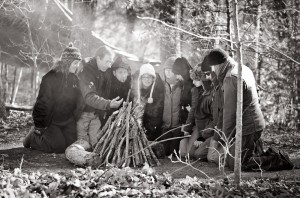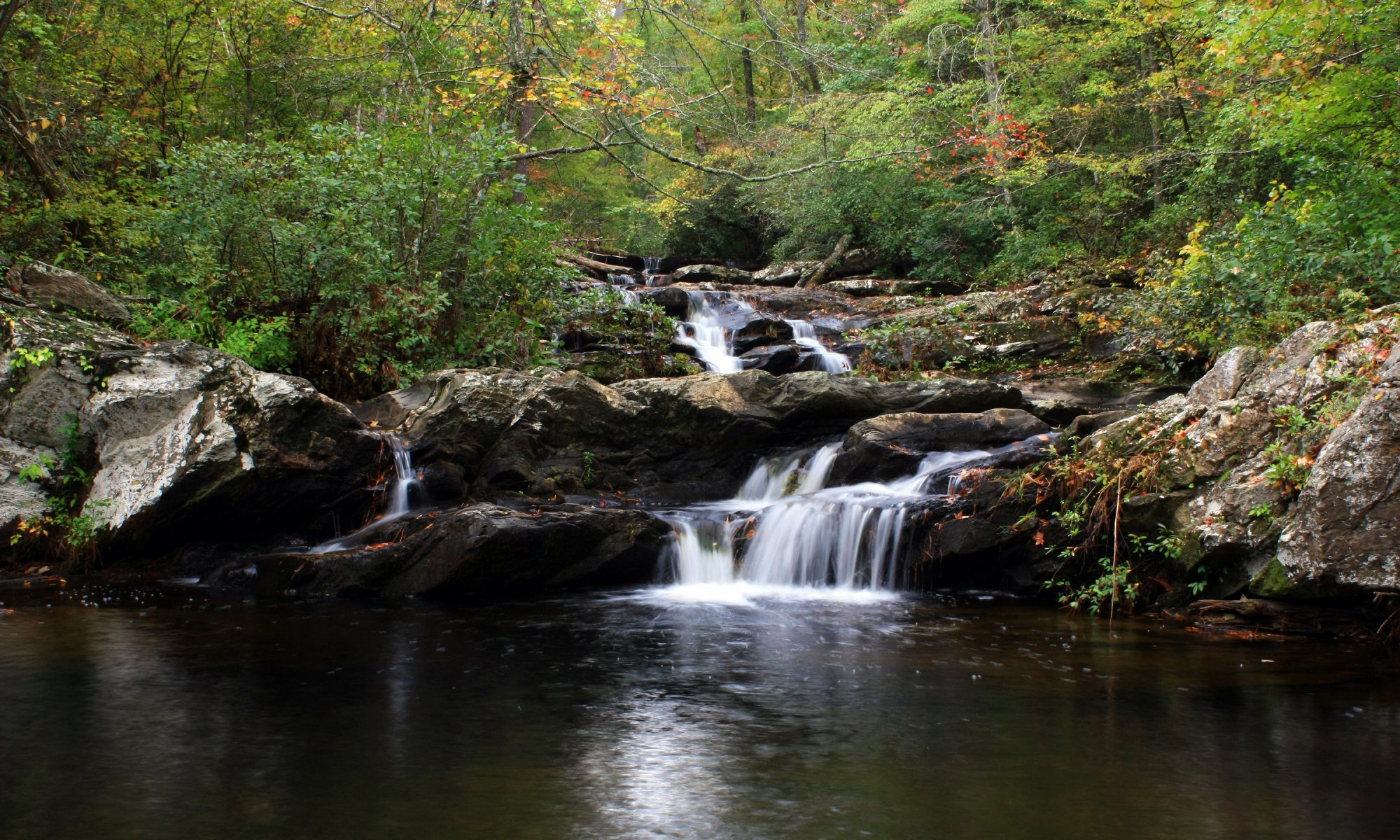MAKING FIRE THE INDIAN WAY

(Reprinted by permission of The North Georgia Journal Magazine.)
By Mark Warren
The Cherokee have a story about a lightning fire on a river island. An old sycamore blazes away as a menagerie of animals gather on the shore and try to claim just one of those elusive flames for their own. It is an epic ordeal in which a tiny spider finally achieves the “impossible.”
The Lakota have their story too. Coyote steals fire from three witches and begins a marathon relay to outrun them. A burning stick is passed from animal to animal in a breathless chase that ends with old frog being cornered by the witches. He spits the fire-stick into a tree stump. And the stump swallows it! This is the one I particularly like, because if you know how to ask a tree, it will give fire back to you. I’ve gotten fire from spiders too, but that was the wrong kind of fire.
Fire has been the heart of our homes since the beginning of history. The root of the word “hearth” tells us that. Fire still draws us, even if in the form of a TV. Fire burning coal, heating water, making steam, turning wheels to make electricity. It’s still fire.
Someone long ago bent over a piece of dead wood and worked out the
problem. This person was brilliant. We have no idea who it was – man,
woman or child. Though there are various methods of coaxing fire from dead wood, this person likely twirled a thin straight stick briskly
between palms, letting the bottom end grind into a slab of wood. The
result was heat – and a little dusting of dark ash that powdered around
the bowl-like depression bored out by the rotating drill. This ash cooled very fast but showed promise. This paleo-genius cut a notch out of the slab. The notch intruded slightly into the bowl so that the ash could fall into it and accumulate the heat of friction in an additive way.
I can’t tell you how much I admire that notch-maker. When I first
attempted to create fire I approached it like I was the “first man.” I
purposely did not read up on it. I labored every night for two months
with pieces of dry wood and developed world class blisters and calluses and raised the definition of exhaustion way beyond Noah Webster’s imagination. Rings of hot ash faithfully rose to the lip of my bowl as the spinning wood curled smoke into my face. Each time I felt I had amassed enough ash, I carefully scraped the charred powder into my waiting nest of bark fibers – the same kind used by birds and squirrels to insulate their homes. But always the ash had already cooled. Had I traveled through the tunnel of time and been dropped into that ancient world I would not have been that paleo-genius.
So I went to a book and saw it drawn out in a diagram. There was the
notch – just like a slice of pie cut from the wood. That night I made
fire. It was pure magic.
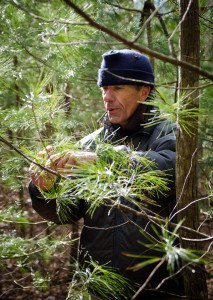 Not every tree will give you fire. Generally the trees that possess the gift of fire are the softer hardwoods like basswood, buckeye, tulip magnolia, willow, poplar and a host of others. But there are surprises on the list. Hickory, redbud, sycamore, some maples and a few other trees with hard reputations will give up fire. Pines seem to be too resinous. But the beautiful exception among pines is the white pine – so plentiful in north Georgia. I know better than to name a tree and say “It can’t be done.” One day somebody will prove me wrong. But I can say with confidence that certain trees loyally work for you – like white pine. Mostly it depends on the conditions of that particular tree.
Not every tree will give you fire. Generally the trees that possess the gift of fire are the softer hardwoods like basswood, buckeye, tulip magnolia, willow, poplar and a host of others. But there are surprises on the list. Hickory, redbud, sycamore, some maples and a few other trees with hard reputations will give up fire. Pines seem to be too resinous. But the beautiful exception among pines is the white pine – so plentiful in north Georgia. I know better than to name a tree and say “It can’t be done.” One day somebody will prove me wrong. But I can say with confidence that certain trees loyally work for you – like white pine. Mostly it depends on the conditions of that particular tree.
Let’s start from scratch and see how to create fire. But let’s jump to
another evolutionary level of the process – one still challenging but
enhanced by a brilliant invention from yet another nameless
paleo-genius. We shall use a small inflexible bow designed to do all
the spinning of the drill and spare your hands all that abrasion.
But first things first. You must learn to make a fire with one match. Your structure of sticks must have an empty fist-sized “garage” in its basement, for this is where your flaming nest of tinder must be “parked” beneath your fuel when you finally have success without a match. Knowing how to make fire without understanding how to build a pyre is like making a fine saddle but having no horse.
Choosing the Tree
Trees that have swallowed fire tend to be more porous. Two pieces of dead wood (from the same tree) with such a grain can grind against one another with more traction – more grit, if you will. Think of rubbing two wire screens together compared to two smooth sheets of the same metal. Porous trees are porous because they grow fast. Trees that grow fast need lots of water; therefore, they grow best in low areas. Here lies the paradox in tree selection. Some of the best species for fire creation live in moist valleys where each night a soup of cool humid air bathes the lowlands.
On the positive side, many trees let their lower branches die as the availability for sunlight is robbed from them by higher branches. These
defunct limbs can hang on for years so that the tree becomes a convenient drying rack for its neglected parts. Select limbs without bark. They still may be moist, but they can dry in the sun. In north Georgia you can seldom rely on wood that’s been in contact with the ground – unless a drought is in session.
White pine is the tallest tree in the Southeast. There are liabilities, but climbing up the ladder of dead limbs on a white pine can get you above the “soup-line.” Better yet improvise with a long branch that you can hook over your coveted limb to snap it off with a jerk. Careful of your eyes here. This tree snaps fast and hard. By accomplishing this step with a long rope tossed over the limb, you can stand well out of harm’s way. Of course, a purist would make this rope out of plant fibers. A good day’s work.
Before leaving this section on tree selection, here are a few more good
tree candidates. Some are native, some aren’t; but all can be found in
north Georgia: birch, box elder, cedar, juniper, sassafras, sumac, hemlock, sweet gum, mimosa, and princess tree. That sampling, in addition to the ones already mentioned, gives you twenty trees to choose from to get started. Just make sure the wood you are using is dead but not rotten.
Fashioning your Fire Kit
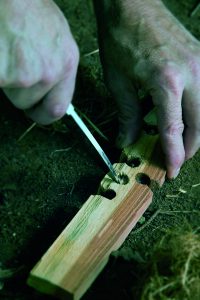 You need a slab of wood for your base that we’ll call the board. As it lies plank-like on the ground it needs to be at least two finger-widths across, one finger-width high and long enough for you to step on it and still have several inches showing beside your foot. You can carve this or split a piece of wood. Try to achieve one flat side for the bottom.
You need a slab of wood for your base that we’ll call the board. As it lies plank-like on the ground it needs to be at least two finger-widths across, one finger-width high and long enough for you to step on it and still have several inches showing beside your foot. You can carve this or split a piece of wood. Try to achieve one flat side for the bottom.
The drill needs to be straight and sharpened at both ends. Its thickness varies with the strength of the fire-maker. For starters try one that matches your index finger in cross-section. A long drill – say a foot- makes the work easier on your spine and makes the bowing (that we will get to) less confining. A straight section of limb saves a lot of carving. Except for the two pointed ends needed, it is ready for action. The drill does not need to be absolutely cylindrical. It can be hexagonal or whatever as long as the thickness is homogenous. But make it straight. A straight drill can be carved out of a curved stick. Like the sculptors say just visualize the finished sculpture inside your wood and remove everything else.
You now have the two basic implements – the pieces that will create friction. The horizontal board will lie flat on the ground while the vertical drill will spin on it from the perpendicular. Since we will be using a bow to do the spinning rather than our palms, we will need something to hold the top of the drill in place. Keeping the drill steady along one axis (no wobbling) is vital to success. This socket can be hardwood, bone, stone, part of an old bottle, or any number of things you might find.
The one used most often by practitioners of primitive woods lore is probably hardwood, simply because it’s easy to find. But a wooden socket has its basic problem with added friction that works against your efforts. Lubricants such as body oil squeezed from facial pores or ear wax or nut oil can help. Lubricant should never be applied to the lower end of the drill. In fact, never touch this tip. That’s where we want friction.
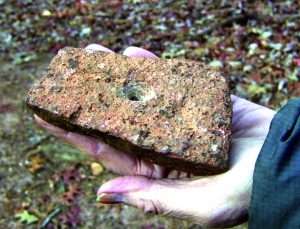 The red clay of north Georgia is the result of lots of iron in the soil – which means we have lots of rocks with iron in them. Iron rusts. Many of our reddish rocks can be ground by harder rock – mortar and pestle style – to create a divot large enough to hold the top of the drill in place. If you use the right materials this takes fifteen seconds. This is my favorite socket because it is self-lubricating with its own talc-like powder.
The red clay of north Georgia is the result of lots of iron in the soil – which means we have lots of rocks with iron in them. Iron rusts. Many of our reddish rocks can be ground by harder rock – mortar and pestle style – to create a divot large enough to hold the top of the drill in place. If you use the right materials this takes fifteen seconds. This is my favorite socket because it is self-lubricating with its own talc-like powder.
A good bow measures the length of your slightly curved arm. It should be stiff and strong (dead hardwood) and curved along one axis only; in other words, as you hold it out to examine it, turn it one way and you see the curve turn it ninety degrees and it looks straight. The shallower the curve the better your work transfers through this tool into the drill.
Notch the bow at each end to accommodate tying a slack rope to it. A little trial and error in loading the drill onto the bow will teach you how loose the rope should be. And since the making of cordage is another lesson unto itself, for now let’s use commercial rope – something you will come to revere in time should you pursue primitive purism. (Making your own rope is by far the most challenging part of the process.) Use non-slick, non- stretch rope 1/8″ or slightly larger.
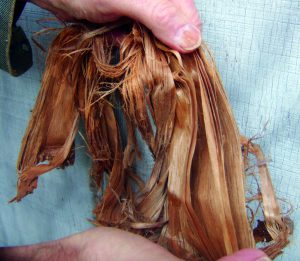 Tinder is the material that will actually burst into flame. For this we want a double handful of fibers – fibers from dead dry weeds rubbed by hand, dead inner tree bark frayed and softened by crushing into a ball, abandoned nests of birds or squirrels, downy seed fluff, brown pine needles beat to a pulp, lint, dead grasses, and on and on. It has been written by at least one survival expert that grasses alone will not do the trick – that grasses should merely bulk up your collection of better fibers; but this is not true. What is critical is that the tinder be dry and fibrous. Wet fibers can dry while you assemble the rest of your kit. Just separate and flatten them on some spreading branches in direct sun above the ground.
Tinder is the material that will actually burst into flame. For this we want a double handful of fibers – fibers from dead dry weeds rubbed by hand, dead inner tree bark frayed and softened by crushing into a ball, abandoned nests of birds or squirrels, downy seed fluff, brown pine needles beat to a pulp, lint, dead grasses, and on and on. It has been written by at least one survival expert that grasses alone will not do the trick – that grasses should merely bulk up your collection of better fibers; but this is not true. What is critical is that the tinder be dry and fibrous. Wet fibers can dry while you assemble the rest of your kit. Just separate and flatten them on some spreading branches in direct sun above the ground.
It is possible to extract dry inner bark fibers from dead limbs even on a rainy day if the outer bark is still in tact. If you remember, I warned you earlier that outer bark holds moisture in. It also keeps it out. This is one of many contradictions nature teaches her students.
Now the components of the kit are gathered, but the kit is not ready to make fire. Remember that glorious notch? With knife point or stone, gouge a small divot into the top of the board near one end, about a finger’s thickness from the edge of one long side. This little hole will secure the bottom point of your drill (the “hot end”) so that you can drill into one spot.
Loading Drill to Bow
If you are a right-hander, hold the bow horizontally in your right hand
with the rope to the left of the bow. With your left hand point the “hot end” of the drill toward the bow under the rope. Secure the near end of the bow in the notch of your pelvis so you can use two hands to snake the rope around both ends of the drill then force the drill perpendicular to the curved plane of the bow until it pops into place. If there’s no “pop”, it’s too loose. If you do this properly, the drill ends up loaded outside the letter D made by the bow and rope – not inside the D.
Drilling a Bowl
With the board on the ground, step just to the left of the divot with your left instep then kneel to the earth with your right knee well back from the board but your weight forward on the left foot. Arrange your posture so that your left shin is vertical, so that you feel you could pounce forward like a cat. Place the “hot end” of the drill in the divot on the board. With your left hand settle the socket divot on the “cool end.” Now brace your left wrist against your left shin and hold the drill in place with the one hand. With your right hand grasp that near end of the bow.
What remains is technique. As in all wilderness skills, strength is a huge asset, but form is the real secret. Push and pull the bow in long smooth strokes and watch the world’s first power drill at work. It is brilliant. Keep the bow and rope and socket parallel to the earth at all times. Don’t let them rock. Keep the drill vertical. This is the point at which drilling is easiest. Enjoy it while it lasts. Meanwhile you are sculpting a precision-fit ball-and-socket joint with drill and board and making lots of smoke. When the bowl has ground down the point of the drill and grown to the size of your drill’s thickness, stop bowing. See that ring of dark powder that emerged from the bowl? That’s what I scraped together for two months.
Cutting the Notch
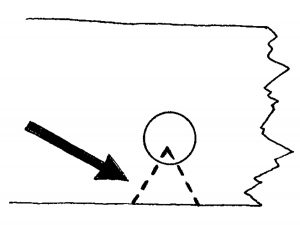 Imagine your bowl is a blackberry pie and you get the first slice, but there is a dead housefly baked into the crust at dead center. I’m assuming you will not want that fly. Cut almost to the center but not quite and continue the wide end of the slice right out of the board. Your slice of pie (from the dead fly’s point of view) must be greater than 45 degrees, less than 90. This will allow an adequate accumulation of hot ash and prevent the hot end of the drill from flying out of the bowl like a wooden bullet. This should be the cleanest piece of pie you’ve ever cut – with smooth vertical walls. Now we’re ready.
Imagine your bowl is a blackberry pie and you get the first slice, but there is a dead housefly baked into the crust at dead center. I’m assuming you will not want that fly. Cut almost to the center but not quite and continue the wide end of the slice right out of the board. Your slice of pie (from the dead fly’s point of view) must be greater than 45 degrees, less than 90. This will allow an adequate accumulation of hot ash and prevent the hot end of the drill from flying out of the bowl like a wooden bullet. This should be the cleanest piece of pie you’ve ever cut – with smooth vertical walls. Now we’re ready.
Making Fire
Place your nest of tinder under the board so that the hot ash will fall into it. Press the fibers down so they don’t stick up through the notch. Reload the drill onto the bow, assume your kneeling posture, cap off the drill with the socket and lock your wrist to your shin, and grip the bow. This is the point at which I always pause to admire the gifts at hand. Wood and stone and plant fiber. And my determination. It is a good time to speak to these gifts and their Maker. It is like saying grace before a meal.
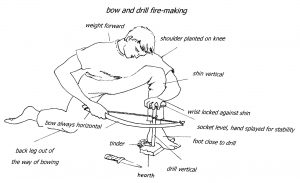 Bow with long smooth strokes until you feel the drill really “bite” into the wood. This is something you learn to feel. The smoke will thicken. Now speed up a little while putting more pressure down on the socket. When your notch is full of smoking ash, stop bowing and carefully, gracefully remove the drill and then your foot while holding the board in place with your hand. You do not want to disturb that slice of ash pie in the notch.
Bow with long smooth strokes until you feel the drill really “bite” into the wood. This is something you learn to feel. The smoke will thicken. Now speed up a little while putting more pressure down on the socket. When your notch is full of smoking ash, stop bowing and carefully, gracefully remove the drill and then your foot while holding the board in place with your hand. You do not want to disturb that slice of ash pie in the notch.
Lift away the board from the ash and tinder very, very carefully by holding the tinder in place. If the slice of ash pie collapses, you may lose your heat. Lift the tinder like it is a cup of liquid gold filled to the brim. With your fingertips gently enfold the hot smoldering ash with the nest of tinder and blow into the tiny opening you have left. Blow quietly with a long, firm jet of air from the tight circle of your lips until the tinder ignites. Place this under your pyre and let your war cry carry through every hill and hollow of north Georgia. I’ll be listening.
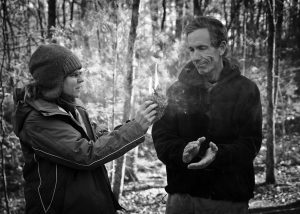
Common Problems
1. The rope slackens and doesn’t spin my drill. Pinch the rope to the bow with the right hand fingers to tighten it. Better yet, stop and retie the rope tighter. Or you may have constricted the center of your drill with rope compression. Carve the drill into a cylinder again.
2. The rope travels up or down on the drill and slips off one end. You are rocking the bow. Keep it level with the earth. Or perhaps your drill tapers a bit. Carve it into a better cylinder. You can also learn to guide the rope back in place with pressure while bowing.
3. The drill is REALLY hard to spin. The cool end of the drill may be clunky inside the socket. The original point has ground away making too much friction there. Re-taper it. Or the drill right above the hot end has some little bumps or edges that are now hitting the lip of the bowl and probably sounding like a wounded seagull. Carve away those edges. Don’t carve the blackened hot end itself.
4. The drill is flying out like a rocket at me! Your notch is too big. Start another bowl.
5. My shoelaces get caught in the drill and rope. Move your shoelaces out of the way.
6. I can’t accumulate enough ash to stay hot. Your notch is too small. Widen it.
7. I’ve tried everything and it’s just not working. I quit! Try another tree. There were teachers in ancient times who gave their fire-students pieces of oak to use as a kit. Oak may be impossible. These students worked for months until their form and temperament pleased their mentor, at which point he handed them cottonwood or sage. And then like me that night when I first carved my notch, they made fire.
Volume two of my Secrets of the Forest series details pyre-building, firemaking, bow drill, hand drill, wood selection, and so much more. This volume also includes storytelling and ceremony. Ceremony – largely lost in the current American culture – brings to life an invisible abstraction, like bravery, determination, generosity, or empathy. It places the student on a personal and private path of self-improvement “to be the best of who he/she can be” . . . by choice! Ceremony can open the door to an intimate relationship with nature. It in no way trespasses upon religious beliefs, but concentrates on bettering oneself, no matter what his/her spiritual leanings.
